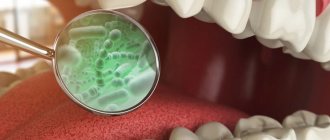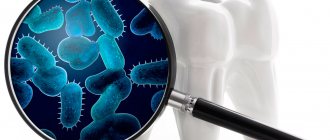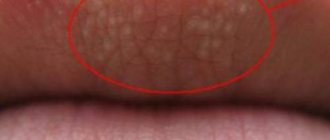Features of the oral cavity
The mucous membrane of a healthy child's mouth is bright pink due to the large number of blood vessels. As she grows older, her shade fades.
The epithelial layer is distinguished by tenderness and vulnerability, as well as some dryness due to the not very active work of the salivary glands (up to 3-4 months).
The baby's mouth is ideally suited for sucking. A wide tongue, a fold on the gums formed by the mucous membrane, pads on the inside of the lips, a “suction cup” on the upper lip - all this provides a tight grip on the bottle or nipple and facilitates the process of obtaining food.
What features or problems can be detected by looking into a baby’s mouth? Main options:
- white bumps on the palate;
- abnormal appearance or position of the tongue;
- white plaque on the inside of the mouth.
"Epstein's Pearls"
In 65-85% of babies after birth, several yellow-white tubercles with a diameter of 1-3 mm are found along the palatine suture. They are called palatal cysts or “Epstein's pearls.”
They are formed from residual fragments of the epithelial lining, which is destroyed under the influence of enzymes during fetal development. Epstein Pearls are filled with keratin.
Palatal cysts do not require treatment and do not cause discomfort to the child. They atrophy on their own in the first months of life.
Language
Normally, the tongue is located along the midline of the jaw. If there is a constant deviation (recession) to the right or left, parents should show the child to a neurologist. This symptom may indicate damage to the caudal group of nerves of the skull. An additional sign is a drooping soft palate.
Another reason to seek help is that the language is too broad. This symptom is observed with hypothyroidism (decreased functional activity of the thyroid gland) and some genetic syndromes.
The listed phenomena are rare, unlike a short hyoid frenulum. This minimal anomaly in the structure of the maxillofacial apparatus can be determined visually; in addition, when screaming, the tip of the baby’s tongue rises. A short frenulum is not dangerous, but it can make sucking difficult and, in the future, complicate the pronunciation of sounds. In infancy, it is easily cut with a scalpel in an outpatient setting without suturing and virtually no blood.
Severe genetic pathologies accompanied by pathologies of the child’s maxillofacial area
| Pathology | Manifestation | Accompanying pathologies | Forecast |
| Hypertelorism | The eyes are far from the bridge of the nose, like in animals | Accompanies severe hereditary pathologies - Edwards, DiGeorge, Apert, Noonan, Wolff-Hirschhorn, cat cry, Loys-Dietz, Hurler, Morquio syndromes. Children suffer from organ development abnormalities and mental retardation | Children have serious developmental problems and die at an early age |
| Meckel's syndrome | Protrusion of brain tissue from the cranial cavity (encephalocele) | Improper development of the kidneys, lungs, brain and limbs | Children die in utero or in the first hours of life |
| Craniostenosis | Early closure of sutures and fontanelles on the child’s head. Irregular shape of the skull – flat on one side and elongated on the other | Strabismus, increased intracranial pressure, seizures, epilepsy, mental retardation | In severe cases, which are registered in utero, children remain disabled |
| Holoproencephaly, | Absence or underdevelopment of the nose in combination with close placement of the eyes and a “cleft palate” | The brain may not be divided into hemispheres or may not be properly developed | Children die at an early age or in utero. |
| Microphthalmia | Underdevelopment of the eyes | Blindness, seizures. Boys may experience pathologies in the development of the genitourinary system | Disability |
| Treacher Collins syndrome | Irregular shape of the skull. Underdevelopment of the chin, mouth and ears | Deafness, seizures, heart defects | Children often die from heart pathologies |
| Pierre-Robin syndrome | Underdevelopment of the lower jaw, cleft palate | Cataracts, abnormal organ development, heart defects | Children often die or remain disabled |
| Crouzon syndrome | Irregular skull shape, cleft palate, reduced midface | Visual impairment, seizures, heart defects | Mental retardation may occur. Sick parents have a high risk of having offspring suffering from the same pathology |
| Pierre Robin syndrome | Underdevelopment of the lower jaw, cleft palate “cleft palate” | Cataracts, blindness, pathologies of the genitourinary system, heart, abnormal development of the spine, absence of limbs | Children remain disabled and often cannot even move independently |
| Down's disease | Underdevelopment of the nasal bone | Heart defects, torticollis, abnormal bone development, deafness | Disability due to mental development disorders |
| Scheithauer-Marie-Sainton syndrome) | Enlargement of the brain part of the skull and reduction of the facial part | Improper bone development. Baby teeth are not replaced by permanent teeth until age 30. | Intelligence is not affected, but there are problems with joints and pathologies of the ENT organs |
| Shereshevsky-Turner syndrome | Underdevelopment of the lower jaw, low position of the ears | Multiple pathologies of internal organs | Children die early from concomitant pathologies |
| Premaxillary agenesis | Cleft palate, splayed nose, wide-set eyes | Brain underdevelopment | Children die immediately after birth |
| Macrostomia | Facial cleft | Underdevelopment of the jaws, cleft palate, deafness, | Poor hearing and difficulty eating can lead to disability |
White plaque
The tongue and palate of an infant may be covered with a thin whitish coating. Main reasons:
- leftover food;
- mouth breathing;
- thrush.
Leftover food
Immediately after feeding, you can see the remains of breast milk or formula on the baby's tongue and palate. After some time, the plaque disappears on its own. Many pediatricians advise removing traces of food from the baby’s mouth, as they serve as a breeding ground for opportunistic microorganisms.
Cleaning methods:
- give the baby 1-2 teaspoons of boiled water immediately after feeding;
- wipe the epithelial membrane 2 times a day with soda solution or water (the procedure is described below).
If the plaque is easily removed or disappears on its own (it is not present before feeding), do not worry. But in cases where white marks on the tongue, palate and inner surface of the cheeks are constantly present, it is necessary to consult a doctor.
Mouth breathing
If a child breathes through his mouth, his mucous membrane dries out and a whitish coating forms on it. In children under one year of age, this phenomenon is most often caused by acute respiratory viral infections and dry air in the room, which leads to the formation of crusts in the nasal passages.
The only way to prevent the formation of white plaque is to restore nasal breathing in the baby. Basic methods:
- when the mucus dries out, instill saline and oil drops into the nose, as well as humidify the air;
- for a runny nose and congestion due to ARVI - similar measures, in addition, the doctor may recommend the use of vasoconstrictor drops (no longer than 5-7 days).
Cleft lip and palate are no longer a death sentence
Simply put, this anatomical defect, due to its similarity with the structure of the corresponding organs in the hare and wolf, is strictly designated as “cleft lip” and “cleft palate.” In medicine it is called cleft lip and palate. Even in the middle of the last century, such a purely external disorder represented an almost insurmountable barrier to the normal development of a child, including speech. Now such problems have already been solved. The main thing is to seek help from the appropriate specialists as early as possible.
FROM THE FIRST DAYS OF LIFE
As a rule, the expectant mother learns that a child will be born with a cleft lip and palate at 16-20 weeks of pregnancy during a screening ultrasound. Heredity affects only 15-20% of cases. The rest is due to infectious diseases, stress and toxicosis that the woman suffered in the first two months of pregnancy, when the maxillofacial skeleton is formed. It is useless to look for reasons and those to blame. It is better to immediately contact pediatric maxillofacial surgeons, send pictures and ultrasound results by email, and keep in touch with specialists by sending pictures of the next ultrasound scans.
The baby, if there are no other problems, will be born in a regular maternity hospital. You need to take a photo of what the defect looks like and send it to the doctor. In the vast majority of cases, the operation is performed when the child is 2-4 months old. Mother and child face a difficult period: due to an anatomical defect, the newborn does not eat well, cannot swallow and suck fully, in order to feed him, he has to use special bottles and nipples.
Breastfeeding is difficult to maintain under such conditions.
But, if surgery takes place within the first month of life, many problems can be avoided. True, this requires specialists who are familiar with the technique of operations on newborns and the appropriate equipment. In the Moscow Children's City Hospital No. 9 named after G.N. Speransky, all conditions came together in 2011. And for the eighth year now, specialists from the First Moscow State Medical University named after I.M. have been at its base. Sechenov operates on newborns with cleft lip and palate.
The youngest patient was only 3 days old. The baby can suckle at the breast the very next day after surgery. On the 6-7th day, mother and child are discharged home.
TO BE CONTINUED
Parents need to be prepared for the fact that the baby will undergo multi-stage treatment with the participation of many specialists. Neonatologists, anesthesiologists and maxillofacial surgeons prepare a newborn for surgery, and, if necessary, orthodontists. After surgery, a small scar remains. It usually takes six months to heal.
At 6-8 months, surgery to correct the palate is performed. It is important to do it before the baby begins to master the first syllables. At 2-2.5 years, if necessary, correction of the lip and nose is carried out, at 4-4.5 years, the alveolar process defect is eliminated. All this time, the child’s development is closely monitored by a pediatrician, neurologist, maxillofacial surgeon and psychologist. When the baby begins to master speech, a speech therapist is involved. An orthodontist monitors the baby's jaw development. The same specialist, if necessary, straightens the teeth, corrects the primary and then the permanent bite. If teeth need to be restored (children with cleft lip and palate sometimes have two missing upper front teeth), an orthopedic dentist is involved. In total, 10-15 specialists are involved in the treatment. Thanks to their efforts, the main problems are solved before school. In adolescence, if necessary and desired by the teenager, minor cosmetic problems remaining after operations are eliminated.
***
AN EXPERT IS HERE TO HELP YOU
Adil Mamedov
,
dentist, honored doctor of the Russian Federation, laureate of the international humanitarian award ICPF, doctor of medical sciences, professor, head. Department of Pediatric Dentistry and Orthodontics of the First Moscow State Medical University named after I.M. Sechenov
***
Operations to eliminate cleft lip and palate are carried out at the expense of the compulsory health insurance fund, that is, they are free for the baby’s parents.
For treatment in the appropriate clinic, you need to receive a referral in form 057u and pass the necessary tests.
***
A cleft lip and palate is only a physical defect. It does not affect mental health and mental abilities. Among the people born with this feature, there are famous scientists, great athletes, and famous musicians.
Source: Happy Parents
The essence and causes of thrush
Microscopic yeast-like fungi of the genus Candida live on the mucous membranes and skin of every person. They do not cause harm to health, but only if the immune system suppresses their active reproduction. Otherwise, an inflammatory disease called candidiasis occurs. If fungi colonize the oral mucosa, candidal stomatitis, or thrush, is diagnosed.
The disease is detected in 4-5% of infants. Its main reasons:
- low level of immunity, characteristic of all newborns;
- decrease in protective forces as a result of teething, acute respiratory infections, dysbiosis, intestinal infection, and so on;
- non-compliance with hygiene standards - insufficient cleaning of children's dishes, toys, mother's skin (during breastfeeding);
- antibiotic treatment, which disrupts the balance of bacteria on the mucous membranes;
- drinking sweet tea, water, compote or a mixture - leftover sugar in the mouth contributes to the growth of fungi.
In addition, a baby can “get” too many candida when in contact with adults. Most often, infection occurs during childbirth if the mother has genital thrush. Kissing and sharing utensils can also lead to infection if an adult has candidal stomatitis.
Causes of development of intrauterine facial defects
Since the causes of congenital anomalies in children have not yet been studied, a child with such abnormalities can appear in almost any family, regardless of lifestyle, place of residence, number of births and health of the parents.
Reasons that significantly increase the likelihood of deformities:
- Unfavorable heredity.
Apparently healthy parents can be carriers of various gene mutations that appear in their offspring. These deviations account for 7-8% of congenital pathologies. - Spontaneous mutations are
disturbances in the fertilization process caused by random, sometimes unclear reasons. - TORCH infections suffered during pregnancy
(toxoplasmosis, rubella, herpes, cytomegalovirus infection). The influenza virus has an adverse effect on fetal development. - Mother's age is over 35 years.
In a woman’s body, the reproductive function begins to fade during this period, and the eggs “overripe”, becoming inferior. Their fertilization is fraught with genetic abnormalities. - Concomitant
metabolic diseases, pathologies of the heart and lungs in the mother. Conception and development of the embryo occurs in unfavorable conditions. Gestation is hindered by the need to constantly take vital medications. - External factors
- living in an environmentally unfavorable area, working with harmful substances. Some teratogenic (deformity-causing) compounds are not eliminated from the body for a very long time. These include formaldehyde, benzene, phenol, dioxin, and arsenic. - Taking medications that affect the development of the child
. Often, deformities occur if a woman takes substances that are not recommended during pregnancy - sedatives, sleeping pills and even some painkillers. - Smoking, drinking alcohol and drugs.
In such women, the risk of having a child with facial development anomalies is increased several times.
Patients included in these risk groups require careful ultrasound monitoring throughout pregnancy. But since pathologies can occur without obvious reasons, every woman needs to undergo such an examination. The Diana clinic has a modern ultrasound machine that allows you to thoroughly examine the baby’s face.
Symptoms of oral candidiasis
The main sign of thrush in an infant is a permanent white coating, reminiscent of cottage cheese or yogurt, on the tongue, palate, gums, inner surface of the cheeks, and lips. At first it looks like small spots (“plaques”), which gradually grow. If you remove them with a bandage, a bright red inflamed mucous membrane is revealed.
As the disease progresses, the white spots become yellow or grayish. Small bleeding erosions form under them. The child experiences discomfort, therefore behaves restlessly and sleeps poorly. When sucking, the unpleasant sensations intensify, as a result, many infants refuse to eat.
In severe cases, fungal microflora leads to the formation of a dense film on the oral mucosa. Over time, it spreads to the throat, tonsils, esophagus and internal organs. The child may have a fever and a significant deterioration in general condition.
Treatment of viral stomatitis in children
The course of treatment for viral stomatitis in children depends on the timeliness of visiting a doctor, as well as the age and state of the child’s immunity. It may include:
- Rinse
As a rule, the dentist recommends treating the mucous membranes of the oral cavity with anti-inflammatory drugs. Also, for viral stomatitis in children, you can use decoctions of certain plants (calendula, chamomile, sage) or an infusion of oak bark. For small children who do not know how to rinse their mouths, irrigation can be done using a regular rubber bulb.
- Treatment with ointments and oils
After rinsing, for the treatment of viral stomatitis in children, sea buckthorn oil or vitamin A (in oily form) is usually used, which is used to lubricate the aphthae. If viral stomatitis in children is caused by herpes, the doctor will prescribe a special ointment. To treat the oral cavity with oils and ointments, you must use cotton swabs.
- Antipyretic and painkillers
Since the disease occurs with an increase in temperature and causes very painful sensations in the baby, the doctor prescribes appropriate medications. For example, for viral stomatitis in children, drugs such as Nurofen and paracetamol can be used.
Help for thrush
A pediatrician may suspect thrush based on an examination of the oral cavity. To confirm the diagnosis, it is worth taking a swab from the throat and determining the state of the microflora. If the number of Candida fungi exceeds the norm, the child has candidal stomatitis.
Local treatment
In most cases, local treatment of thrush is carried out in infancy. The safest method is to wipe the oral mucosa with baking soda. Stages:
- Prepare a weak solution of soda - 1 small spoon per 1 glass of boiled warm water.
- Wrap a sterile bandage around your clean index finger.
- Soak the bandage in a soda solution.
- Wipe the baby's mouth. There is no need to try to remove the plaque, just carefully treat it from above.
The procedure should be repeated every 2-3 hours for several days. If the child does not open his mouth, you should press your finger on the chin and hold it.
Another method of treatment is wiping the mouth according to the scheme described above with a solution of honey and warm water (in a ratio of 1:2). Honey has antimicrobial and anti-inflammatory effects. But you should remember that it is a very strong allergen.
If traditional methods do not help get rid of stomatitis, the doctor may prescribe external antifungal agents. Here are some of them:
- acidophilus powder;
- Candide solution;
- nystatin ointment;
- Shostakovsky balm;
- gentian violet solution and so on.
The method of their use is indicated in the instructions. Usually it is necessary to apply an ointment or solution to the mucous membrane several times a day. The duration and dosage are determined by the doctor.
Systemic drugs
In case of advanced candidiasis, systemic antimycotics are prescribed in parallel with local remedies in a dosage that is safe for a small child. The main drugs are Diflucan, Mycomax, Nystatin, Amphotericin B, Ketoconazole. They should be given to the baby for 5-10 days. It is important to follow the treatment period determined by the doctor, even if the symptoms of candidiasis have disappeared.
If your baby suffers from pain, you can give him ibuprofen in an age-appropriate dosage or paracetamol. In addition, it is advisable to use local analgesic gels, which are used during teething.
Along with the destruction of fungal flora, it is important to pay attention to increasing the child’s immunity. According to the doctor's decision, it is worth giving him B vitamins. If dysbiosis is present, it must be treated. It is recommended that a nursing mother undergo antifungal therapy with her baby, even if she has no symptoms.
Prevention
The risk of developing candidal stomatitis is especially high in the first 6 months of a baby’s life, since his immune system is just developing. To prevent disease, it is important to follow the following rules:
- rinse your breasts with clean water before feeding;
- offer the baby some water after a meal or burping;
- strictly observe the rules of hygiene for all adults in contact with the child;
- Regularly sterilize bottles and pacifiers.
After an illness, to prevent re-infection, it is worth boiling all toys and children's dishes. If the item cannot be treated with hot water, it is recommended to rinse it with a soda solution.
The main reason for a white palate in a baby is the accumulation of food debris in the mouth after feeding. Traces of formula or milk disappear on their own and are not visible before the next meal. Persistent plaque in most cases is a sign of candidal stomatitis (thrush). This disease is treated with local and/or systemic agents with an antiseptic effect. At the initial stage, thrush is not dangerous, but as it progresses it can lead to the formation of ulcers on the mucous membrane and the spread of infection.
Causes of viral stomatitis in children
There are several causes of viral stomatitis in children. This:
- recent infectious diseases: herpes (80% of cases), influenza, adenoviral infections, measles, chicken pox;
- contact with a sick person: a viral type of stomatitis is transmitted by airborne droplets, as well as through some objects (toys, dishes, personal hygiene items, etc.);
- weak immunity.
Viral herpes in children is one of the most common forms of damage to the oral mucosa. This can be explained by the fact that babies are very sensitive to the herpes virus, and if one of the family members gets herpes, there is a high probability that the child will develop stomatitis.










